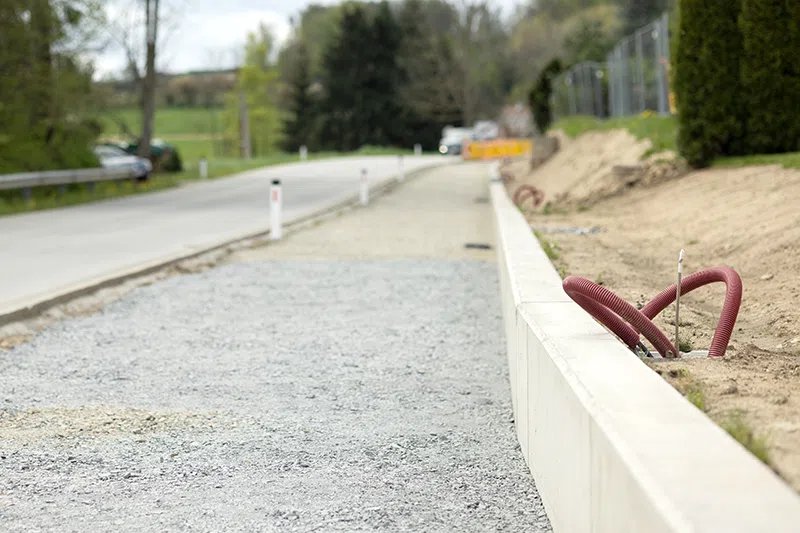When it comes to concrete sidewalk installation, drainage might not be the first thing that comes to mind, but it should be. Proper drainage is essential for ensuring the long-term durability and safety of your sidewalks.
Without adequate water management, even the best-laid concrete can crack, shift, or erode over time. For homeowners, businesses, and municipalities alike, understanding how drainage affects installation can prevent costly repairs and extend the lifespan of walkways.
This blog explores the vital role drainage plays in concrete sidewalk projects and offers practical guidance for achieving optimal results.
Protects Against Cracking and Surface Damage
Poor drainage is one of the most common causes of cracks and surface degradation in concrete sidewalks.
- Prevent water pooling: Standing water on the surface can weaken concrete over time and lead to cracking or pitting. Sloping the sidewalk slightly away from buildings and installing nearby drainage channels can prevent accumulation.
- Control soil moisture levels: Excess water in the soil beneath the sidewalk can cause expansion and contraction that leads to cracking. Installing gravel bases and compacted subgrades helps regulate moisture and provides stability.
- Avoid freeze-thaw cycles: In colder climates, trapped water can freeze and expand, damaging the surface. Proper drainage minimizes water retention and the risk of freeze-thaw damage.
Preserves Sidewalk Stability and Leveling
Sidewalks need a solid, dry base to remain level and safe for pedestrians. Improper drainage often leads to shifting or uneven surfaces.
- Ensure subgrade drainage: Installing a well-compacted, properly drained subgrade keeps the foundation from settling unevenly. Using materials like crushed stone helps with water movement under the concrete.
- Install edge drains or trench drains: These systems direct water away from the sidewalk, especially in areas with high rainfall or sloped terrain. They help maintain long-term structural integrity by keeping the base dry.
- Grade the surrounding landscape: Direct surface water runoff away from sidewalks by adjusting the slope of nearby soil and lawns. This reduces water infiltration and preserves sidewalk alignment.
Reduces Erosion Around the Sidewalk
Water that flows uncontrollably near sidewalks can erode soil and undermine the edges, leading to instability and unsightly gaps.
- Use proper downspout placement: Redirect roof runoff away from walkways using splash blocks or underground extensions. This prevents concentrated water flow from washing out the soil around sidewalks.
- Incorporate landscape barriers: Adding curbs or swales around sidewalks helps guide water to appropriate drainage paths. This reduces erosion and keeps edges intact.
- Install geotextile fabric: This material beneath the sidewalk and base prevents soil migration while allowing water to drain. It adds protection against erosion and subgrade weakening.
Extends the Lifespan of the Concrete
Water damage is one of the leading causes of premature sidewalk failure. Managing drainage as part of your concrete sidewalk design increases durability and return on investment.
- Minimize saturation exposure: Consistent drainage design keeps moisture levels stable, preventing long-term saturation that deteriorates concrete strength.
- Maintain joints and seams: Proper drainage prevents debris and moisture from accumulating in expansion joints, reducing the risk of joint failure and edge crumbling.
- Protect against rebar corrosion: Water intrusion can lead to rusting of any embedded reinforcement materials, weakening the structure. Drainage helps preserve internal integrity.
Enhances Safety and Reduces Liability
Water accumulation on sidewalks can create safety hazards for pedestrians and expose property owners to legal risks.
- Avoid slick or icy surfaces: Standing water that doesn’t drain properly can create slipping hazards or freeze into ice patches in winter. Sloped surfaces and drainage features reduce these risks.
- Prevent trip hazards: Soil washout or settling from poor drainage can cause uneven slabs. This not only endangers pedestrians but may also result in costly liability claims.
- Encourage routine inspections: Regularly checking for pooling, runoff issues, or erosion helps identify drainage problems early and keeps sidewalks safer over time.
Proper drainage isn’t just a bonus—it’s a critical component of any successful concrete sidewalk installation. From protecting against cracks and erosion to extending the sidewalk’s lifespan and improving safety, drainage planning should be a priority from the very start of the project.
Whether you’re managing a small residential walkway or a large commercial path, investing in the right drainage solutions ensures lasting performance and peace of mind.

